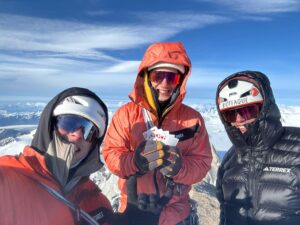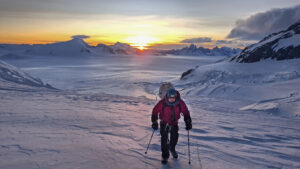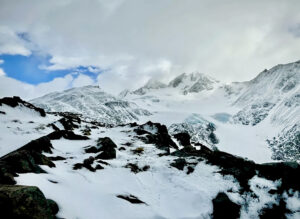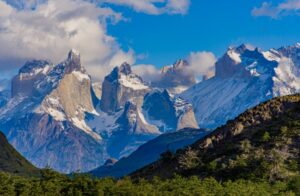Two years in the logistics phase, 45 days on the ice: That’s what it took an elite French military mountaineering team to pull off a stunning expedition.
Late last year, five alpinists attached to Le Groupe Militaire de Haute Montagne (GMHM) traversed over 600km to link two famous Patagonian ice fields: Campo de Hielo Norte and Campo de Hielo Sur.
Multiple outlets including Rolando Garibotti’s PATAclimb have characterized the expedition as “unprecedented.” Even at cursory inspection, it’s clear that it took a massive amount of work.
To execute it, the team negotiated vast tracts of featureless ice, deep gorges filled with meltwater, and segments of jagged crevasses. They used techniques from kite skiing to (inflatable) kayaking to long-term snow cave survival. And along the way, an untimely injury threatened to dismantle the mission entirely.
PATAclimb credited Didier Jourdain with conceiving of the adventure when he scoped out the terrain during a flight home from an Antarctic expedition several years ago. He, Thomas Auvaro, Leo Billon, Jordi Noguere, and Christophe Malange made up the crew. A sixth member, Commander Jacques-Olivier Chevallier, was also locked into the roster but a reported appendicitis attack sidelined him at home in France. (However, his resulting position at the rear of the expedition would come into play later, Montagnes Magazine reported.)
The journey got underway in Lago Leones, the team’s access point for the plateau of the Campo de Hielo Norte.
The men proceeded to trudge the 120km of the Hielo Norte, pulling 100-kilogram loads behind them on pulks. Within two weeks, they found themselves at an inlet where they began kayaking.
Six days of paddling later, they packed up the inflatable boats and broke out the kite skiing gear on the Campo de Hielo Sur.
According to Montagnes Magazine, everything proceeded according to plan — until the team encountered its first two major obstacles.
The kites let them travel swiftly on the wings of the wind, at a reported clip of about 150km a day. That led them to Reicher Falls, a pinched glacier traverse. They cleared it and headed for a formation Montagnes called “le Bastion,” a 500m wall guarded by snow mushrooms and seracs.
Then the notorious Patagonia weather took root. The punishing wind howled in at 130kph, trapping the team in a snow cave for five days, Montagnes said.
When it “calmed down” to 80 kph, they emerged and pushed on toward the Bastion.
Then — as the team roped up and picked their way through a field full of jagged ice blades and deep crevasses — disaster occurred.
“I was thrown off balance by the rope, I slipped down the slope and fell vertically, directly on my hip, 5 meters below,” Malange told Montagnes. “No blood, no open fracture… the inventory is rather reassuring but the diagnosis carried out by satellite telephone with a doctor from the EMHM is clear: there is a fracture somewhere. Emergency services must be called.”
Montagnes reported that’s when Chevallier sprang into action. From his position in France, he proved “extremely valuable in the rear base to manage the rescue,” Malange said. Ultimately, the four uninjured team members shuttled him down to a tent in a safer area. Then, thanks to a tiny weather window, a helicopter evacuated him without further strife.
“It was the only flyable day for the helicopter,” Malange recalled to Montagnes. “A day later, it would have taken 7 to 10 days and a big fight to get me back down to the fjord where a boat would have picked me up. It would have been much more complicated and would probably have compromised the rest of the expedition… Finally, I was lucky!”
Malange eventually underwent emergency surgery for a fractured femoral head in nearby Punta Arenas, Chile — also thanks to reported logistical help from Chevallier.
Meanwhile, the delay resulted in consequences for the remaining team members. Hamstrung by yet another episode of bad weather, they dipped into their emergency rations while they awaited their chance to clear the Bastion, Montagnes said.
Ultimately, they carried on to a slightly less southern terminus than they originally planned. PATAclimb’s in-depth report offers direct insights into the specific stresses of the mission.






